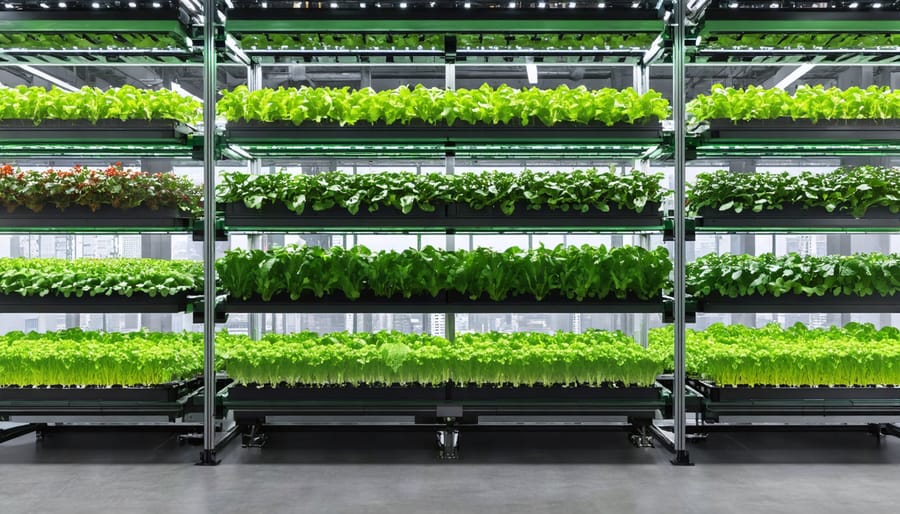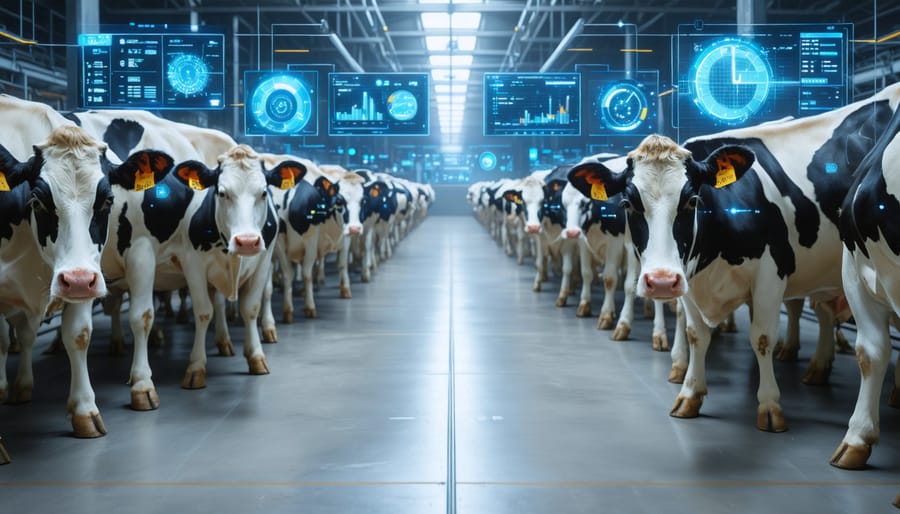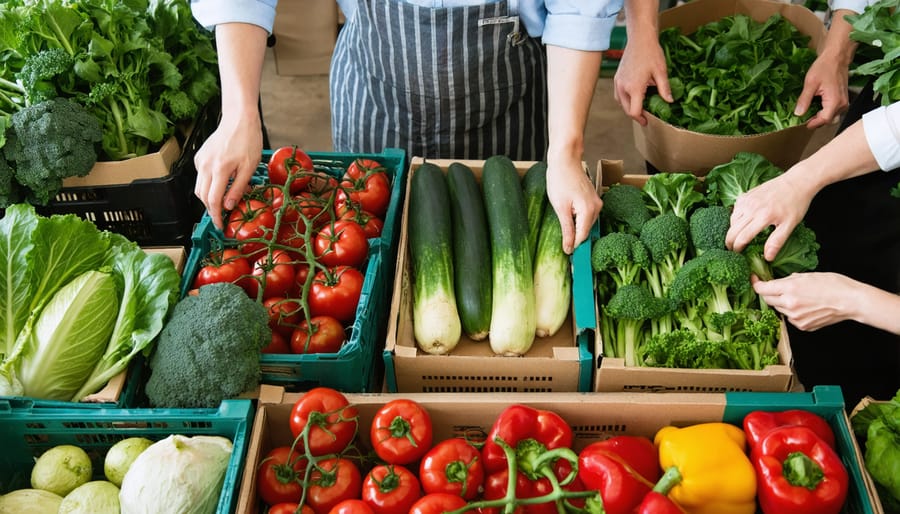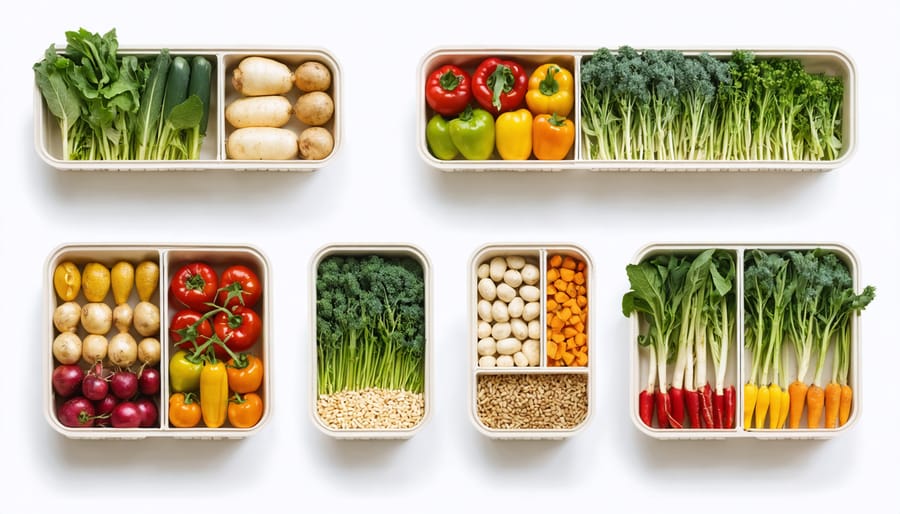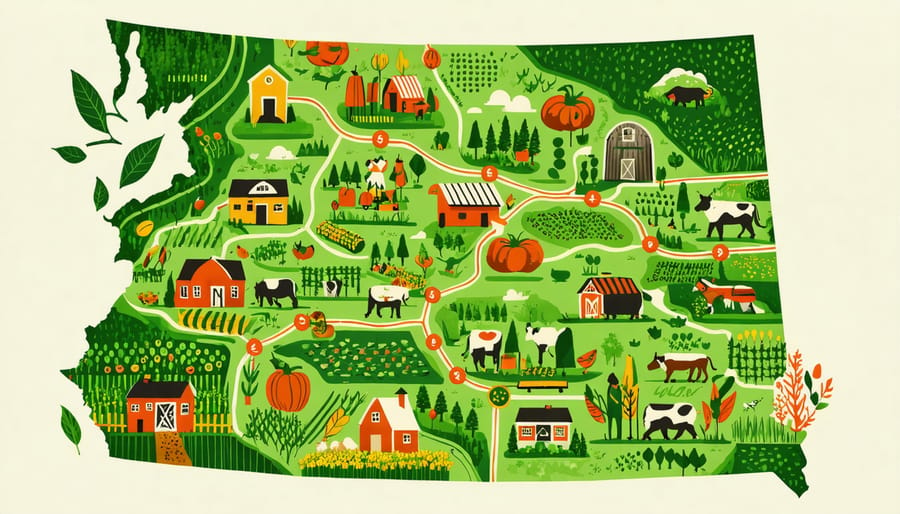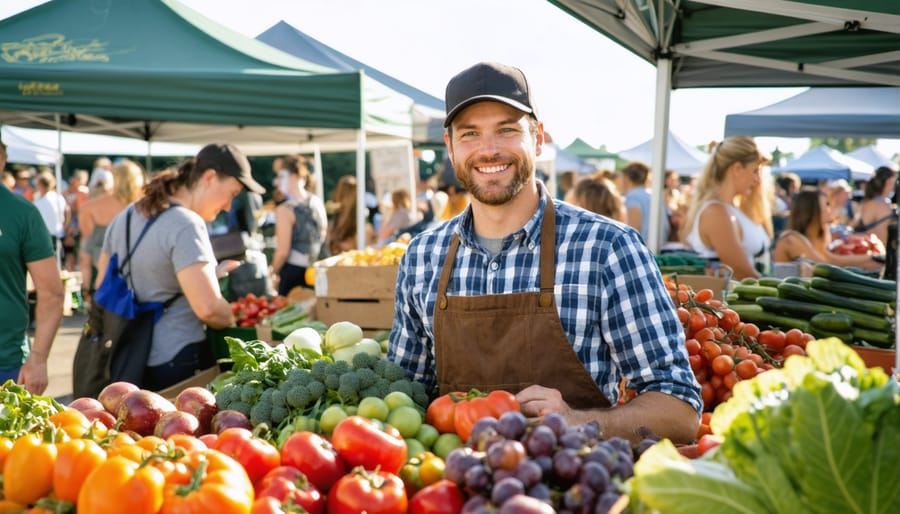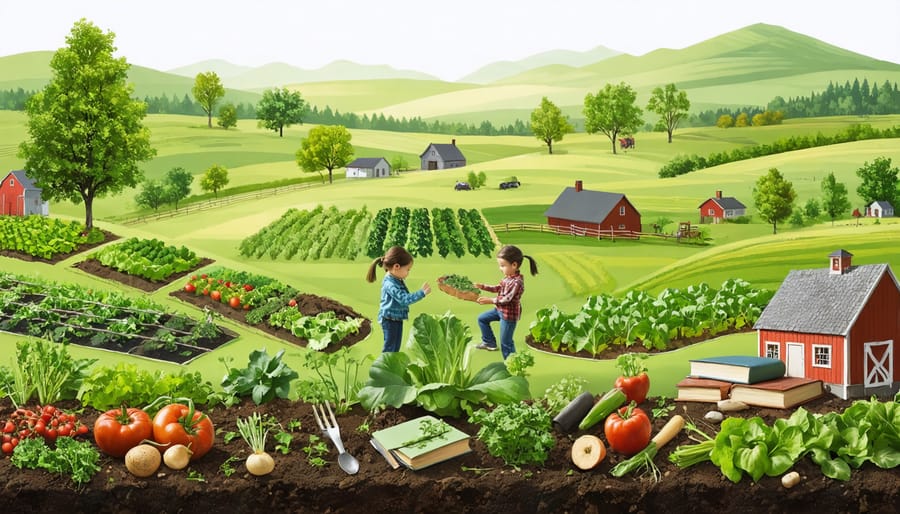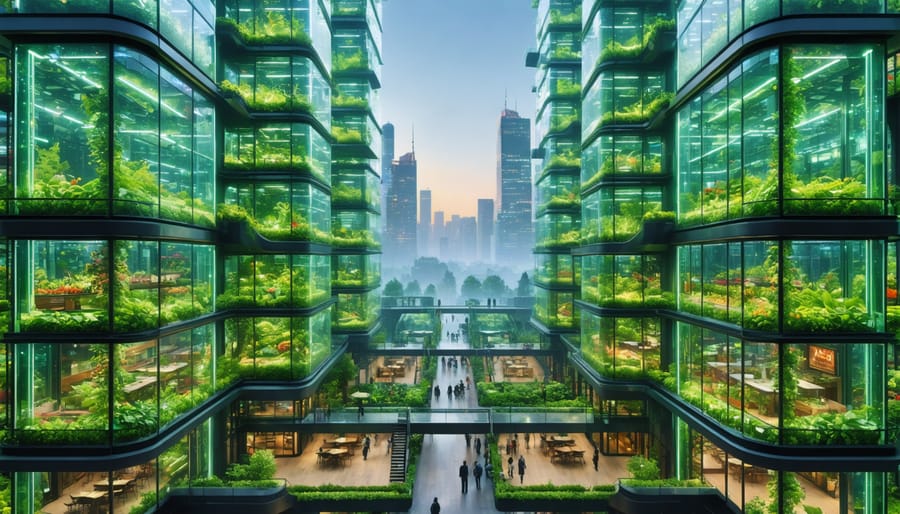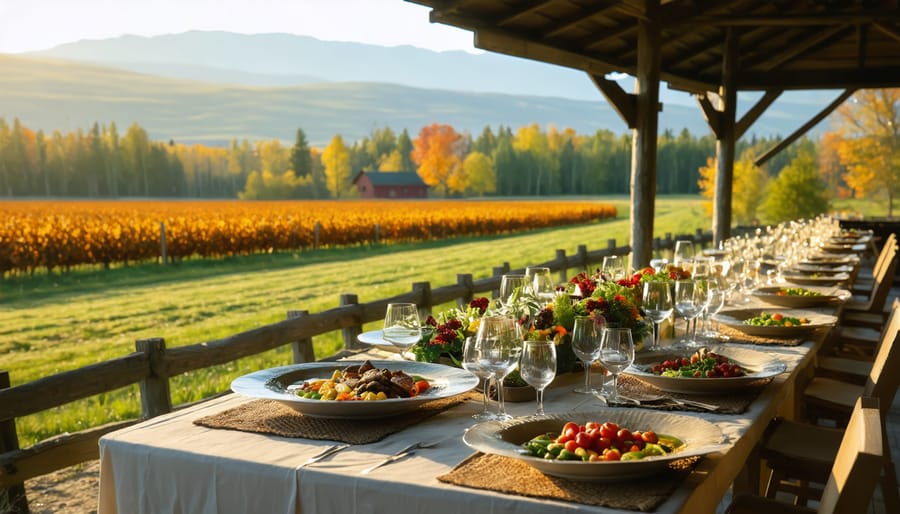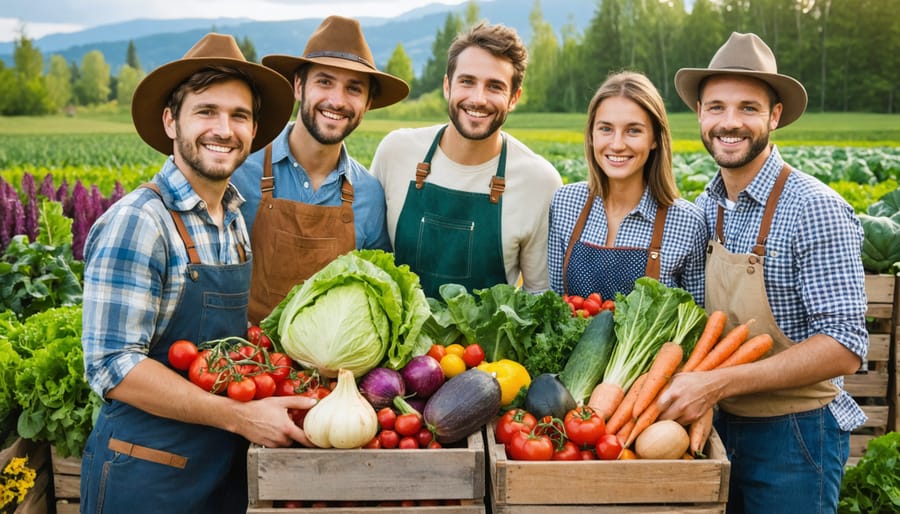In the heart of Alberta’s evolving agricultural landscape, vertical farming technology stands as a revolutionary solution to our growing food security challenges. By stacking crops in controlled environments, these sophisticated systems produce up to 350% more yield per square meter than traditional farming methods, while using 95% less water and eliminating the need for pesticides.
Canadian farmers are increasingly turning to vertical farming as a year-round growing solution, particularly vital in our northern climate where traditional growing seasons are limited. From Edmonton to Calgary, innovative agricultural operations now leverage LED lighting, hydroponics, and smart climate control systems to cultivate fresh produce mere kilometers from urban centers.
The technology’s impact extends beyond production efficiency. Vertical farms significantly reduce transportation emissions, with some Alberta facilities delivering fresh produce to local markets within hours of harvest. This farm-to-table revolution not only ensures peak nutritional value but also strengthens local food security and creates sustainable agricultural jobs in urban areas.
As global food demand rises and arable land becomes increasingly scarce, vertical farming emerges as a practical, sustainable solution that aligns perfectly with Canada’s commitment to agricultural innovation and environmental stewardship. The future of farming isn’t just growing outward—it’s growing up.
How Vertical Farming Transforms Canadian Agriculture

Year-Round Production in Alberta’s Climate
Alberta’s challenging climate, with its short growing season and extreme temperature variations, has traditionally limited agricultural production to specific months. However, vertical farming technology is revolutionizing year-round food production in our province. By creating controlled environments, farmers can maintain optimal growing conditions regardless of external weather patterns.
These indoor growing systems maintain temperatures between 20-25°C throughout the year, allowing for continuous cultivation cycles. LED growing lights compensate for reduced daylight hours during our long winters, while advanced climate control systems manage humidity levels and air circulation. This means producers can harvest fresh produce every month, even during January when outdoor temperatures can plunge below -30°C.
Local vertical farm operators are reporting 12-15 harvest cycles annually for leafy greens, compared to just 2-3 cycles in traditional outdoor farming. This consistent production helps stabilize local food supply and reduces dependence on imported produce during winter months.
Calgary-based farmer Sarah Thompson notes, “We’re growing fresh basil and lettuce in February, something that would’ve been impossible five years ago. Our energy costs are offset by the premium prices we receive for locally-grown winter produce.”
The technology is particularly valuable for urban areas across Alberta, where fresh produce demand remains high year-round but traditional farming isn’t feasible.
Resource Efficiency Meets Sustainability
Vertical farming revolutionizes resource management through innovative design and technology. In Alberta’s climate, where water conservation is crucial, these systems typically use 95% less water than traditional farming methods through recirculation and precision delivery systems. A 100-square-metre vertical farm can produce the equivalent yield of 400 square metres of conventional farmland, making it particularly valuable for urban areas and regions with limited arable land.
Energy efficiency in vertical farms continues to improve with the integration of LED lighting systems and smart climate controls. Modern LEDs consume about 50% less energy than previous growing lights while providing optimal spectrums for plant growth. Many Alberta farmers are combining these systems with renewable energy sources, particularly solar panels, to further reduce their environmental footprint.
Space optimization is perhaps the most striking advantage. By growing upward rather than outward, farmers can stack crops in layers, maximizing yield per square metre. A typical six-layer vertical farm setup can produce up to 10 times more leafy greens than a traditional greenhouse of the same footprint.
Local success stories include Red Deer’s community vertical farm project, which produces fresh vegetables year-round while using just 15% of the water required for conventional farming methods. This demonstrates how resource efficiency and sustainability can work together to create viable farming solutions for our future.
Essential Technology Components
LED Lighting Systems
Modern LED lighting for agriculture has revolutionized vertical farming by providing precisely controlled, energy-efficient illumination that supports year-round crop production. These systems can be tailored to deliver specific light spectrums that optimize plant growth and development, resulting in faster growth cycles and improved crop quality.
Here in Alberta, where winter daylight hours are limited, LED systems have become particularly valuable for maintaining consistent production. Local farmers report energy savings of up to 70% compared to traditional lighting methods, while achieving better yields. The ability to adjust light intensity and duration allows growers to create ideal conditions for different crop varieties, from leafy greens to herbs.
Recent innovations in LED technology have introduced features like automated dimming schedules and spectrum adjustment based on growth stages. These smart systems can integrate with climate controls to maintain optimal growing conditions while minimizing energy consumption. For example, the Lethbridge Vertical Farm Co-op reduced their energy costs by 40% after upgrading to new-generation LED arrays, while maintaining the same production levels.
Hydroponic and Aeroponic Systems
In modern vertical farming, hydroponic growing systems and aeroponic technologies have revolutionized how we grow food without soil. These systems deliver nutrients directly to plant roots through water-based solutions or mist, maximizing space efficiency and resource use.
In hydroponic setups, plant roots are suspended in nutrient-rich water, typically using methods like nutrient film technique (NFT) or deep water culture. Here in Alberta, many farmers have found success with these systems, particularly during our harsh winters, achieving year-round production of leafy greens and herbs.
Aeroponic systems take this concept further by misting plant roots with nutrient solution, requiring even less water than traditional hydroponics. These systems use about 95% less water than conventional farming, making them particularly attractive for our prairie regions where water conservation is crucial.
Both methods offer precise control over growing conditions and typically yield harvests 30-50% faster than soil-based farming. Local growers report significant success with these systems, especially in producing high-value crops like microgreens and specialty herbs for our regional markets.
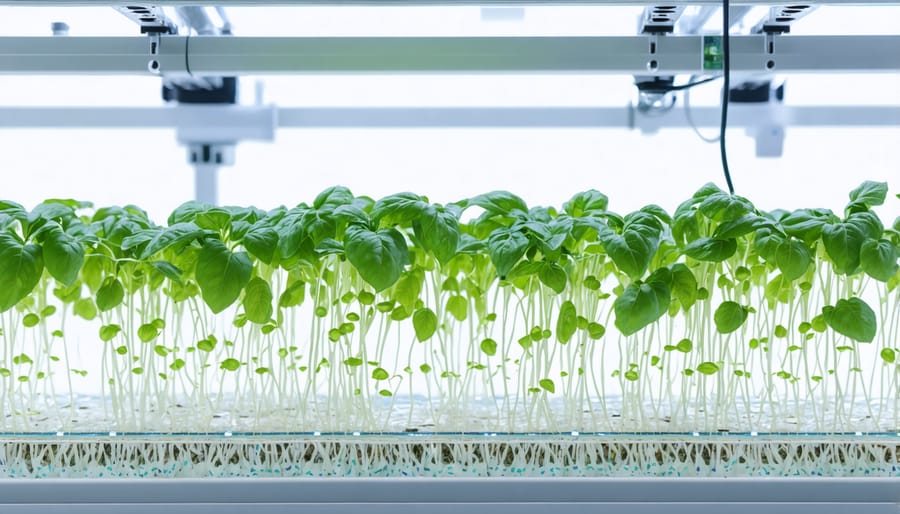
Climate Control and Automation
Climate control in vertical farming relies on sophisticated automated farming systems that maintain optimal growing conditions year-round. Here in Alberta, where outdoor temperatures can swing dramatically, these systems are particularly valuable for maintaining consistent crop production.
Modern vertical farms use integrated environmental controls to manage temperature, humidity, and CO2 levels with precision. Sensors throughout the growing space continuously monitor conditions, automatically adjusting ventilation, heating, and cooling systems as needed. Most facilities maintain temperatures between 20-24°C and relative humidity levels of 50-70% for optimal plant growth.
LED lighting systems work in concert with climate controls, operating on programmed schedules that mimic natural day-night cycles. These systems can be fine-tuned for specific crop requirements, ensuring each plant receives the exact light spectrum and intensity it needs for maximum yield.
Water management is equally automated, with recycling systems that maintain precise nutrient levels while reducing consumption by up to 95% compared to traditional farming. This efficiency is particularly relevant for our prairie regions, where water conservation is increasingly important.
Data Analytics and Smart Monitoring
Modern vertical farms in Alberta are increasingly embracing smart monitoring systems and data analytics to optimize crop production. These systems use networks of sensors to track crucial growing parameters like temperature, humidity, nutrient levels, and plant health in real-time.
For instance, at the Edmonton Urban Farm Initiative, farmers use smartphone apps to monitor their crops remotely, receiving instant alerts if conditions fall outside optimal ranges. This technology has helped them reduce water usage by 35% while improving crop yields.
The data collected through these systems helps farmers make informed decisions about resource allocation and crop management. Temperature sensors ensure precise climate control, while automated nutrient dosing systems maintain ideal feeding schedules. Many Alberta farmers are now using artificial intelligence to predict harvest times and detect early signs of plant stress or disease.
What’s particularly exciting is how this technology democratizes farming knowledge. New farmers can learn from historical data patterns, while experienced growers can fine-tune their operations based on detailed analytics. These systems also help track energy usage and operating costs, making it easier to maintain profitable operations year-round.
Real Success Stories: Alberta’s Vertical Farms
Urban Crop Solutions – Edmonton
Located in the heart of Edmonton’s industrial area, Urban Crop Solutions has emerged as a leading example of successful vertical farming in Alberta. Since its establishment in 2019, this 2,000-square-metre facility has been producing over 450 kilograms of leafy greens and herbs weekly, supplying local restaurants and grocery stores within a 50-kilometre radius.
The facility utilizes a state-of-the-art hydroponic system with LED lighting specifically calibrated for optimal plant growth in the Alberta climate. What sets Urban Crop Solutions apart is their innovative approach to resource management, achieving a 95% reduction in water usage compared to traditional farming methods while maintaining year-round production regardless of external weather conditions.
Farm manager Sarah Thompson explains, “We’ve adapted our growing systems to meet Edmonton’s unique challenges, particularly during the winter months when traditional farming isn’t viable. Our energy-efficient design allows us to maintain production costs that compete with conventional farming methods.”
The operation employs 15 local staff and has developed partnerships with several Edmonton-based restaurants and retailers. Their community engagement program includes monthly tours for local schools and agricultural students, helping to educate the next generation about sustainable farming practices.
Urban Crop Solutions demonstrates how vertical farming can succeed in Alberta’s urban centres while contributing to local food security and sustainable agriculture practices.
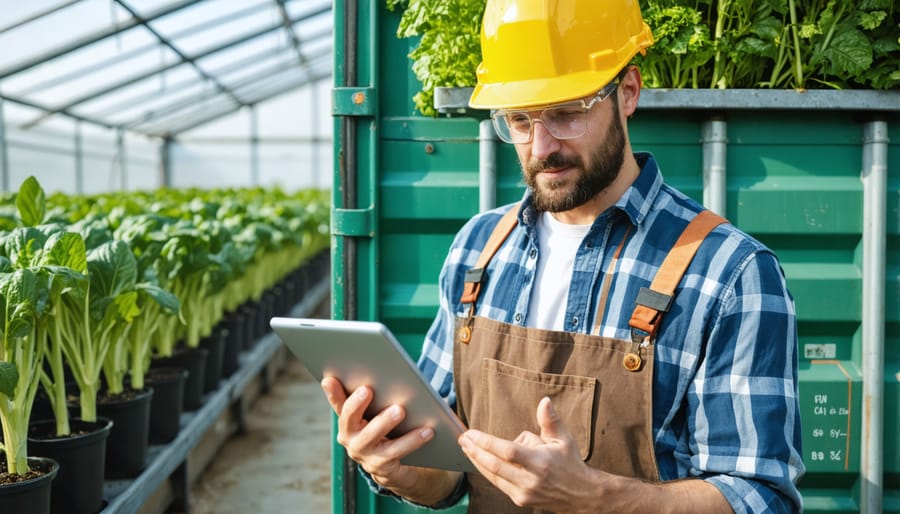
Calgary’s Container Farms
Calgary has emerged as a leader in container-based vertical farming, with several successful operations transforming unused shipping containers into year-round growing spaces. These innovative farms are proving particularly valuable during Alberta’s harsh winters, producing fresh greens and herbs when traditional farming isn’t possible.
One standout example is Agriplay Ventures, operating in southeast Calgary since 2019. Their 40-foot shipping containers each produce the equivalent of 2-3 acres of traditional farmland, while using 95% less water. The company supplies local restaurants and markets with fresh produce year-round, maintaining consistent production even when temperatures drop below -30°C.
Local farmer Sarah Thompson, who converted two shipping containers in 2021, shares her success: “We’re growing 4,000 heads of lettuce monthly in each container. The energy costs are offset by the premium prices we get for truly local, fresh produce in winter.”
The Calgary container farming community has developed strong partnerships with local businesses and educational institutions. The Southern Alberta Institute of Technology (SAIT) now includes container farming in its agricultural technology program, preparing the next generation of farmers for this innovative growing method.
These operations demonstrate how vertical farming can thrive in urban settings while supporting local food security. Most Calgary container farms operate on less than 100 square metres of land, making them ideal for urban spaces where traditional farming isn’t feasible.
Getting Started with Vertical Farming
Initial Steps and Resources
Starting a vertical farming operation begins with thorough research and planning. Connect with Agriculture and Agri-Food Canada’s innovation programs, which offer guidance and potential funding opportunities for sustainable farming initiatives. The Alberta Agriculture and Forestry department also provides valuable resources and consulting services for farmers exploring new technologies.
Consider joining the Canadian Vertical Farming Network, where you can access mentorship programs and connect with experienced operators. Local agricultural extension offices offer workshops and technical support specifically designed for vertical farming ventures.
Essential first steps include:
– Conducting a feasibility study for your location
– Reviewing local zoning and building regulations
– Calculating initial investment requirements
– Developing a business plan
– Identifying potential market opportunities
– Selecting appropriate growing systems
Many successful vertical farms in Alberta started with small pilot projects before scaling up. The University of Alberta’s Agriculture Innovation Hub offers research partnerships and testing facilities for new vertical farming technologies, making it an excellent resource for hands-on learning and experimentation.
Funding and Grant Opportunities
Several agricultural funding programs are available to support Canadian farmers transitioning to vertical farming technology. The Canadian Agricultural Partnership (CAP) offers matching funds of up to $100,000 for innovative agricultural projects, including vertical farming initiatives. Alberta-based farmers can access additional provincial grants through the Agricultural Partnership Program, which specifically supports sustainable farming practices and technology adoption.
Local credit unions and Farm Credit Canada provide specialized financing options with competitive interest rates for vertical farming equipment and infrastructure. Organizations like Agriculture and Agri-Food Canada regularly announce new funding opportunities through their Agricultural Clean Technology Program, particularly for projects that demonstrate environmental benefits and energy efficiency.
For new farmers, the Young Agrarian Program offers mentorship and start-up funding specifically designed for innovative agricultural ventures. Remember to check application deadlines and eligibility requirements, as many programs operate on seasonal cycles or have specific intake periods.
As we look to the future of agriculture in Alberta, vertical farming technology presents a compelling opportunity to strengthen our food security and agricultural leadership. The integration of these innovative systems into our existing agricultural framework could transform how we produce food year-round, despite our challenging climate.
The evidence suggests that vertical farming can complement traditional farming methods, offering new revenue streams for established farmers and opportunities for newcomers to enter the agricultural sector. With Alberta’s abundant renewable energy resources and strong technology sector, we’re uniquely positioned to become a leader in sustainable indoor agriculture.
Our agricultural community has always been adaptable and forward-thinking. By embracing vertical farming technologies, we can create a more resilient food system that serves both urban and rural populations. The potential for job creation, reduced environmental impact, and increased local food production makes this technology particularly attractive for our province’s future.
Looking ahead, success will depend on collaboration between farmers, technology providers, and government support systems. While the initial investment in vertical farming may be substantial, the long-term benefits for Alberta’s agricultural sector could be transformative. As we’ve seen from early adopters in our province, the combination of traditional farming wisdom with modern technology can yield remarkable results.
Together, we can build an agricultural future that honors our farming heritage while embracing innovative solutions for the challenges ahead.

